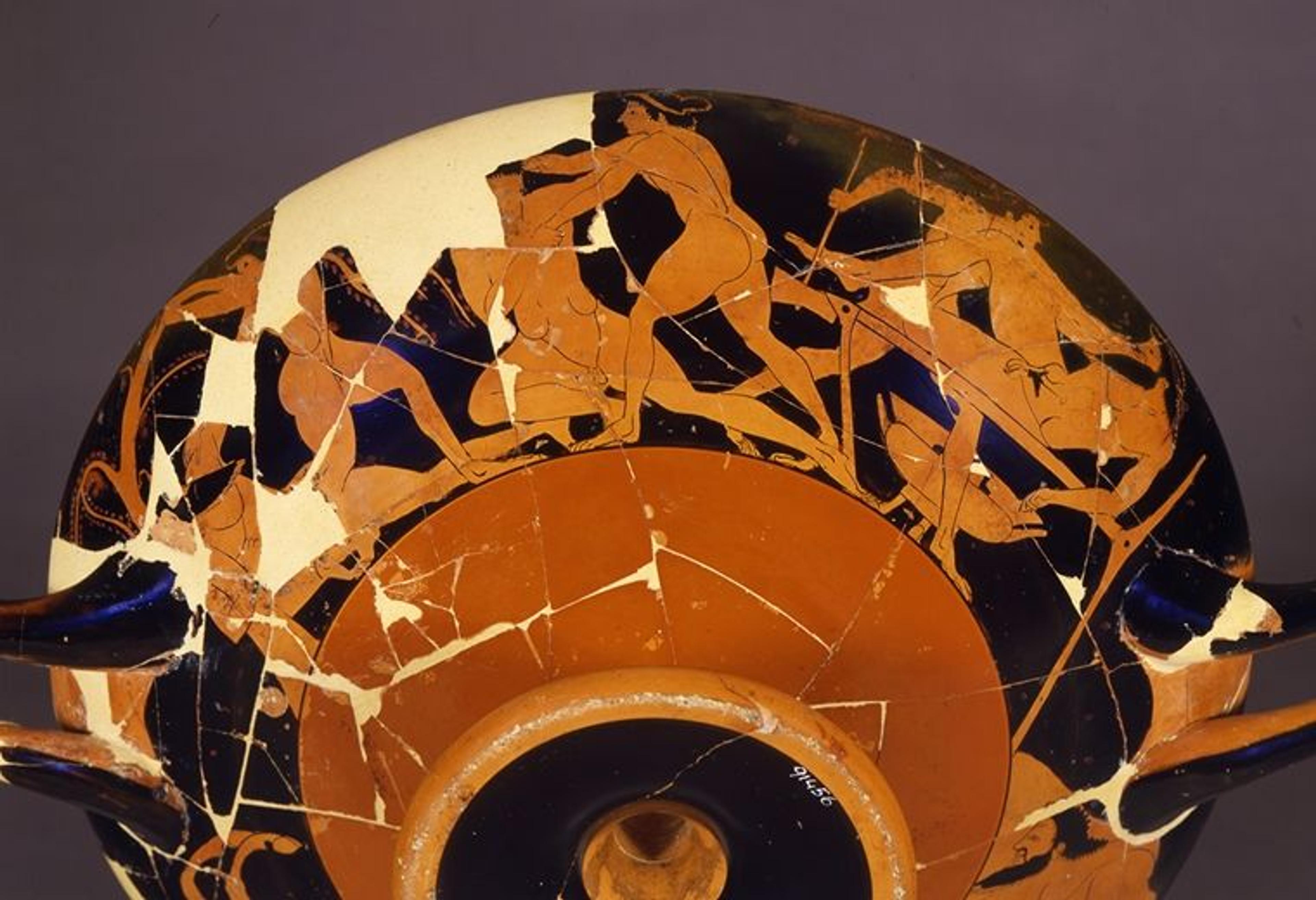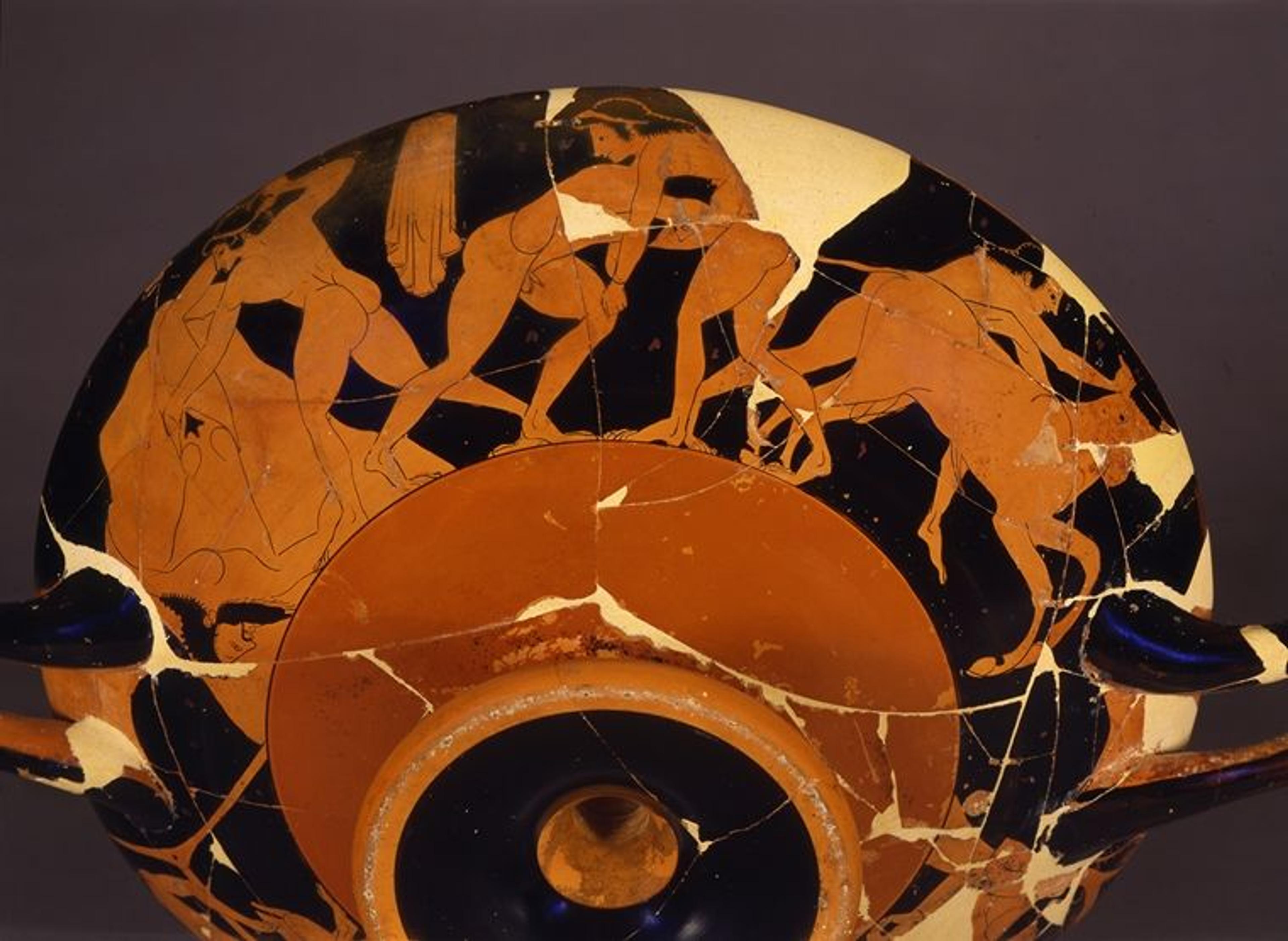During the sixth and fifth centuries B.C., Greek vases, especially those made in Athens, were exported by the thousands to Etruria, the area of present-day Tuscany in west-central Italy. As a four-year loan from the Museo Archeologico Nazionale in Florence, The Department of Greek and Roman Art is fortunate to receive a kylix (drinking cup), datable to about 510 B.C., a time of extraordinary creativity in Athens and of intense export to Italy.

Kylix (drinking cup). Greek, Attic, red-figure, ca. 510 B.C. Signed by Kachrylion as potter. Interior: Eros in flight holding a lotus tendril; exterior: deeds of the Athenian hero Theseus. Museo Archeologico Nazionale, Florence (inv. 91456). Lent by the Republic of Italy, Polo Museale Regionale della Toscana
The cup came to light in 1882 in a major ancient cemetery in Orvieto. The vase is signed twice by the potter, Kachrylion, who both made the cup and applied the rare and fragile coral-red slip that surrounds the tondo (circular field) on the interior and that also appears below the figural scenes on the exterior. Thanks to other works with coral red that he signed, we know that he specialized in this technique. The Met collection also includes an example signed by a contemporary potter, Hegesiboulos (07.286.47).

Interior of the cup depicting Eros
The subjects decorating the Florence cup are remarkable. The interior depicts Eros, the god of love, in flight and holding a lotus tendril (above). The traditional interpretation is that he is flying over the sea, an allusion to the birth of his mother, the goddess Aphrodite, from the waves. A more recent proposal places him between sky and earth as a primal generative force and an intermediary between the divine and mortal realms. This aspect of Eros was the focus of a cult that enjoyed a resurgence in sixth-century Athens.

From left to right: Theseus bending the pine tree; Theseus and the Minotaur; Theseus and Prokrustes
The exterior of the cup presents one of the earliest known programmatic, cyclical depictions of the deeds performed by Theseus on his journey from his birthplace, Troizen, to Athens. These heroic feats are supplemented here by his confrontation with the Minotaur, which took place on Crete. The progression begins with the hero bending the pine tree to which he will bind Sinis; then overpowering the Minotaur; and, finally, about to shorten Prokrustes to fit the length of his bed (above).

From left to right: Theseus and Skyron; Theseus and Kerkyon; Theseus and the Bull of Marathon
On the other side, Theseus upends Skyron into the sea, wrestles Kerkyon, and captures the Bull of Marathon (above). In antiquity, Theseus was credited with consolidating the numerous localities around Athens into one political entity and ridding them of malefactors. As dissimilar as the subjects on the kylix may appear to be, they all focus on Athenian traditions and emphasize unity and order, cosmic and political.
With respect to the appearance of the vase, it is worth noting that present-day practices vary widely as to the amount of restoration ancient objects receive. While all interventions secure the stability of the objects, modern fills may or may not be tinted to blend with adjacent ancient areas.
The cup was on view at The Met Fifth Avenue in gallery 153 from October 2019 through October 2023.
Featured Media
Discover the mythological scenes and innovative decoration of an exceptional drinking cup made in Athens during the late sixth century B.C. and currently on loan to The Met (L.2019.54). Presented by Dr. Mario Iozzo, Director of the National Archaeological Museum of Florence.
